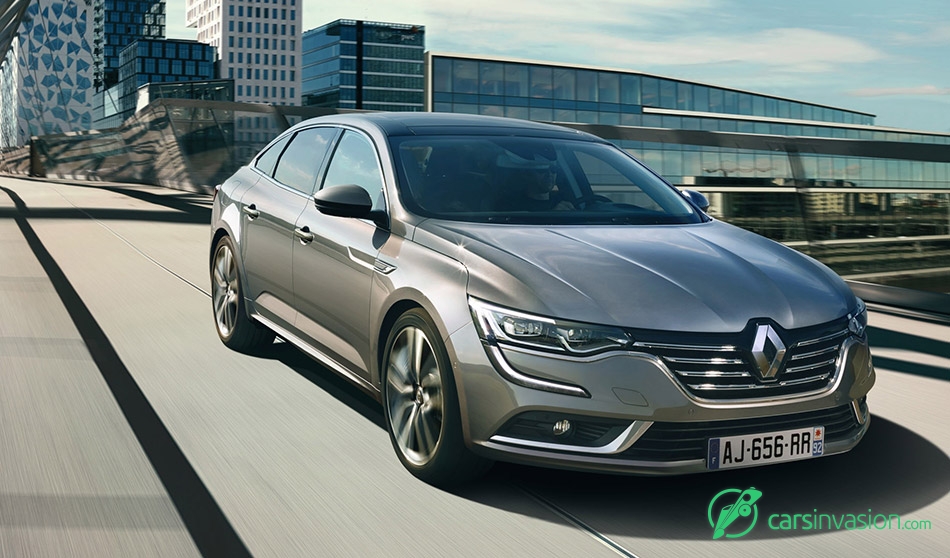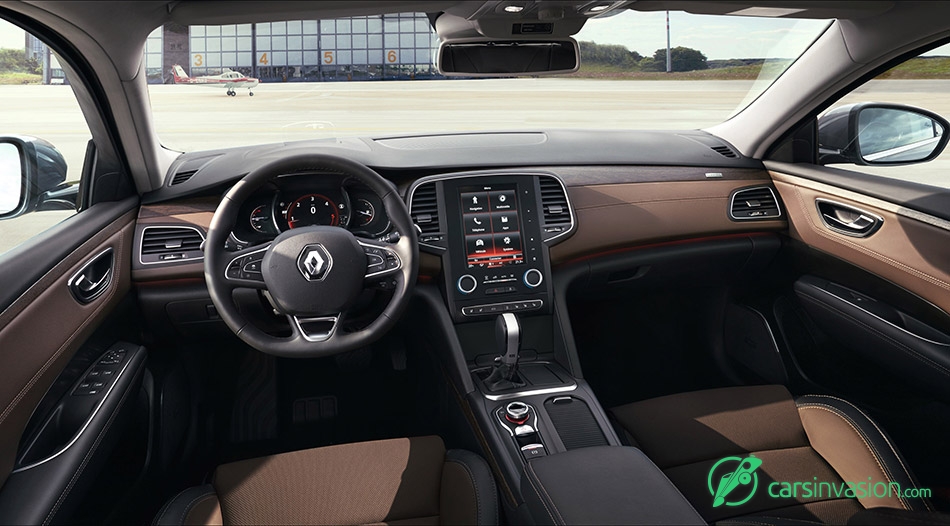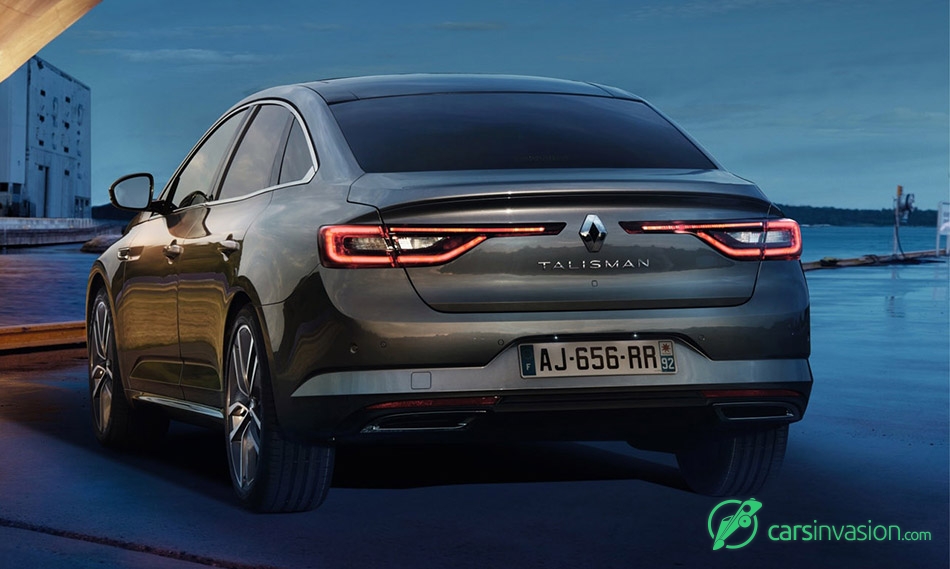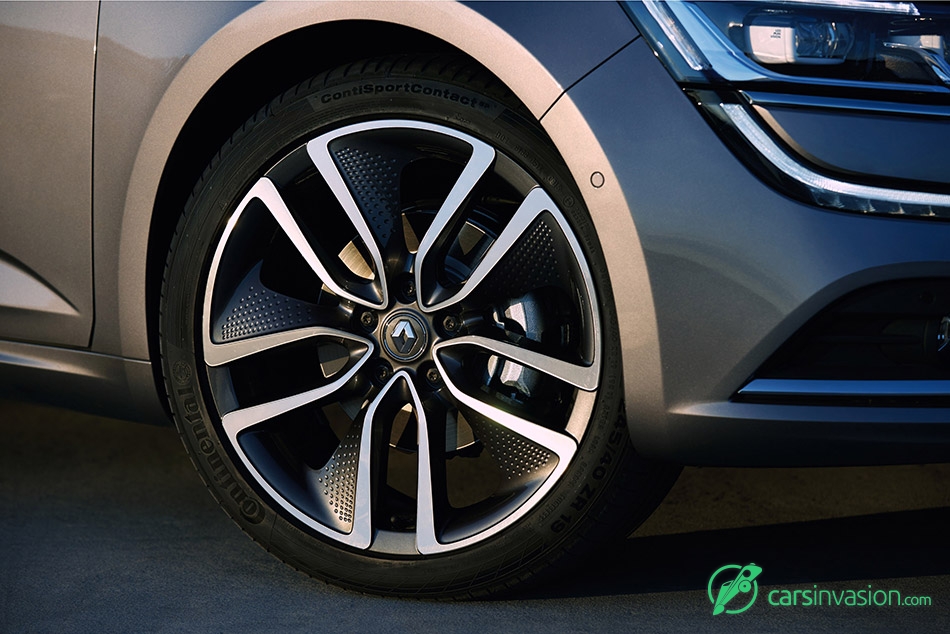The Talisman is built to the very highest quality standards and meticulous attention has been paid to every detail, including, notably, the depth and lustre of its paint.
Low running costs, plus low fuel consumption and CO2 emissions also figure prominently amongst the Talisman's core strengths.
The Renault Talisman, together with the Estate version - which features the same qualities as the saloon - is poised to play an active part in the renewal and upgrading of Renault's high-end range. Both vehicles will be manufactured at the firm's Douai plant in France.
Following its unveil to the media on July 6, 2015, the Renault Talisman - along with the Estate version - will be presented at this year's Frankfurt Motor Show, which opens its gates to the public on September 17. The Talisman will be available for sale in Europe at the end of 2015.
A name that embodies the strengths of Renault's saloon
Renault selects names for its models that symbolise their design and personality across all markets where they are sold.
True to this tradition, the Talisman has been given a charismatic name that conjures up notions of both protection and power. At the same time, Talisman is an easy word to pronounce and is understood the world over.
This three-syllable name rolls easily and naturally off the tongue, yet it asserts the model's powerful personality and the energy it radiates. The combination of the model's strong, racy lines and innovative technologies express protection and safety.
The Talisman delivers intense driving enjoyment grounded in a genuinely sensorial experience.
Saloon car essentials
For the Talisman, Renault designers opted for a three-box body style. The saloon layout - with a distinct boot - picks up on the universally accepted design practice for this type of car, whilst simultaneously blending Renault's warm and friendly DNA into the mix.
To reinterpret the rulebook, Renault's designers went back to basics to establish the ideal proportions and perfect balance between the different volumes. An overall length of 4.85 metres and a width of 1.87 metres endows the Talisman with a generous footprint that is beneficial to interior space and underscores the distinguished apperance expected of a car of this stature.
Renault's designers and engineers worked closely together to keep the roof height to just 1.46 metres and to control ground clearance. They also achieved the ideal one-third / two-thirds ratio between the glazed areas and body panels, plus a 2.81 metres long wheelbase. The long bonnet adds dynamism to the Talisman's profile, and the large diameter wheels (up to 19-inches) are a snug fit within their sculpted arches.
Sleek styling
The Talisman is powerful and inspires confidence from the front with its distinctive chrome grille featuring the brand's upright diamond logo. Renault's new visual signature continues through the Talisman's C-shaped daytime running lights, which extend right down to the bumper. Depending on the version, the Talisman can be equipped with 100% 'pure vision' LED headlights.
The side profile is enhanced by the dynamic shape of the third side window, evoking the world of luxury limousines and the visual promise of generous space inside. The use of chrome underscores the elegance of the Talisman's silhouette, with a strip running the perimeter of the side windows and another on the moulding that straddles the front wing and door. This arrow-shaped feature taps into the design language of sporting cars to suggest performance and aerodynamic efficiency.
The low, broad-shouldered rear incorporates distinctive tail light clusters that extend inwards towards the centreline of the boot. Their elongated shape underscores the car's grounded stance while drawing attention to the Renault logo. 3D-effect lighting provides the Talisman with a powerful visual signature. These lights are always switched on - even during the daytime - to further reinforce their visual impact.
An interior that blends warmth, clean lines and quality in Renault Talisman
Reinterpreting classical design cues to reflect the themes of the exterior styling, Renault's designers conceived an interior that is welcoming and high in quality.
Visually, the cabin is divided into three horizontal planes which serve to structure the space within the vehicle.
The areas closest to the occupants feature an inviting, soft-to-the-touch trim. Elements that are further away are deliberately treated in a 'cooler' manner in terms of colours and materials. This contrast contributes to the impression of space. Lastly, the combination of particular colours and a variety of different materials creates different interior ambiences.
Painstaking attention and imaginative solutions were applied to the Talisman's ergonomics and design, even down to the padding and trim of its interior components.
On-board refinement: a roomy interior, welcoming seats and supreme comfort
The Talisman has many strengths that support its bid to distil a unique impression of comfort and wellbeing thanks to its generously dimensioned, welcoming interior.
A personal welcome and comfort
When the key card holder approaches, the Daytime Running Lights, rear lights and the interior roof light come on, while the door mirrors deploy and down lights illuminate the area around the door. When the driver opens the door, he or she is welcomed by an audible and visual animation on the display. Meanwhile, the seat automatically slides back 50mm (versions with electric seats) to facilitate ingress. Once the driver is seated, it returns to its original position.
A comprehensive, user-friendly multimedia experience
The Talisman comes with three types of multimedia equipment.
The entry level Talisman is equipped with a car radio featuring a 4.2-inch (11cm) display. Depending on the market, this digital radio offers flawless reception and CD quality sound. The signal also carries information in text format, such as a description of what is playing, weather and traffic updates, latest news, etc.
In the case of the intermediate equipment levels, the Talisman comes with the R-Link 2 connected multimedia tablet, with a seven-inch (18cm) landscape format display and Bose Surround Sound.
The high-end equipment level comes with R-Link 2 complete with an 8.7-inch (22cm) portrait format display.
R-Link 2, the Talisman's connected control centre
Along with the functions and ergonomics developed specifically for in-car use, the Renault R-Link 2 connected tablet comes with either a seven-inch landscape format or 8.7-inch portrait display. The latter is a first in the Talisman's class.
The promise of intense driving pleasure courtesy of Multi-Sense technology
Driving enjoyment is one of the key attributes expected of a large family saloon car. Thanks to its low-profile stance, with a centre of gravity and driving position that are close to the road, the Talisman has been honed to deliver real driving pleasure. Taking the spirit that prevailed in the design of the new Espace even further, Renault has employed all of its chassis and engine expertise to equip the Talisman with technological features and innovations that set it apart in its class.
A unique combination of 4Control technology and active damping
Once again, Renault stands out for its innovative flair in mating the 4Control system to electronic damper control in a manner that has never been seen before in a family saloon. This unique combination is responsible for generating driving pleasure, comfort and safety. Around town, the 4Control chassis - a genuine Renault speciality - ensures that the Talisman's size is quickly forgotten by endowing it with extraordinary agility. Out on the open road, the Talisman's cornering stability and safety when evasive action is required place Renault's new saloon in a class of its own.
Personalised driving experience thanks to Multi-Sense technology
Like the new Espace, the Talisman is equipped with Multi-Sense technology. Its saloon car architecture enables it to extract even more of the benefits of this Renault innovation which make a real difference when it comes to driving enjoyment. Multi-Sense controls and co-ordinates the various technologies found in the Talisman to create an immersive driving experience. It is responsible for operating the 4Control system, active damping, steering, engine and EDC transmission. It also covers the instruments, engine sound and ambient lighting.
Thanks to this ingenious system, the Talisman provides access to its occupants' desired mood in the form of four pre-programmed settings: Comfort, Sport, Eco and Neutral, plus a fully configurable Perso mode. It is as if the driver is benefiting from several cars all rolled into one.
On the road, the Talisman innovates and promises to shake up the family saloon car class with its driving sensations and entirely customisable in-car experience.
The Talisman is equipped with an innovation that provides it with a dual personality: a 'shortcut' button which enables the driver to switch in just two clicks from Comfort to Sport mode and vice-versa. The razor-sharp Sport setting offers enhanced driving spirit and dynamism, while the Comfort option eradicates the stresses of longer journeys. Drivers can easily access their two favoured settings and switch from one to the other without having to risk taking their eyes off the road.
Thanks to Renault's Multi-Sense technology, the Talisman gives drivers the impression of benefitting from several cars all rolled into one.
Managed weight and efficient powertrains
The Talisman is powered by efficient, high-performance small-displacement engines. The Talisman's comprehensive range of engine options includes the Energy TCe 200 petrol unit and the Energy dCi 160 and Energy dCi 130 diesels that can also be specified for the new Espace. What's more, these engines perform even better in the Talisman, which is some 200kg lighter than Renault's large crossover, while the new saloon's Cd is a low 0.27.
All of the Talisman's engines benefit from Renault's knowledge and expertise as an engine manufacturer, honed through the brand's participation in motorsport and Formula 1 in particular.
Boasting latest-generation technologies such as direct petrol injection and steel pistons, the Talisman's engines offer both first-rate driving enjoyment and low fuel consumption. These downsized powerplants all bear the 'Energy' label through the fact that they incorporate either one or two turbochargers, Stop&Start technology and energy recovery under braking.
Driving pleasure, from just 95g of CO2 per km
Renault is tirelessly working to improve the efficiency of its petrol and diesel engines by consistently enhancing their performance and driving characteristics while at the same time reducing their fuel consumption and CO2 emissions. This ongoing research and continuous quest for progress endows Renault's conventional powertrains with a level of efficiency that it would have been difficult to imagine only a few years ago.
The 110hp Energy dCi unit offers an astonishing driving experience under the bonnet of the Talisman. It emits just 95g/km of CO2, placing it amongst the most efficient vehicles in its segment. This performance is sufficient to qualify it for the latest ECO2 signature. From June 30, Renault's ECO2 label has been applied to the most economical engine in each model range. This evolution also underlines the favourable positioning of the brand's ECO2 versions in relation to their direct rivals.
Renault continues its range upgrade offensive
Like the new Espace, the Talisman is a concentrate of fundamentals, to which Renault has added sensuous styling, plus a carefully-appointed, comfortable and roomy interior. Featuring high-tech innovations (4Control chassis, active damping, Multi-Sense technology, R-Link2, Bose Surround Sound, etc.), the new Talisman is designed to enhance travelling comfort and pleasure for the driver and passengers alike. But Renault's best must also be affordable, so the Talisman has been engineered to be among the most competitive models in its class with regard to ownership and running costs.
A new application for the Common Module Family (CMF) architecture
The Common Module Family (CMF) project is founded on the principle of using a shared architecture for several Alliance vehicle families, covering several segments of the range. The key is the use of big modules which each make up a different part of the vehicle: front and rear sub-frames, cockpit, engine compartment, electric architecture and electronics. Two or three versions of these modules are available but they all have the same standard component architecture. They can consequently be combined to produce a saloon car, an SUV or a sporting model, depending on the need.
The CMF architectures and big modules will allow the Alliance to benefit fully from the economies of scale that all manufacturers are seeking to achieve.
The Talisman shares its big modules with the new Espace and the advantages are enhanced quality and reliability, plus being able to enhance the specification with attributes the customer will appreciate - made possible by the modules' reduced production costs.
Source: Renault


























